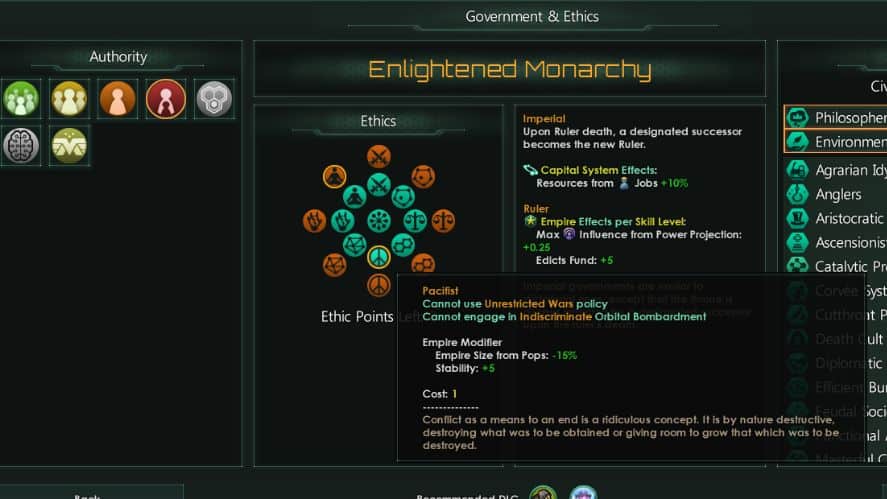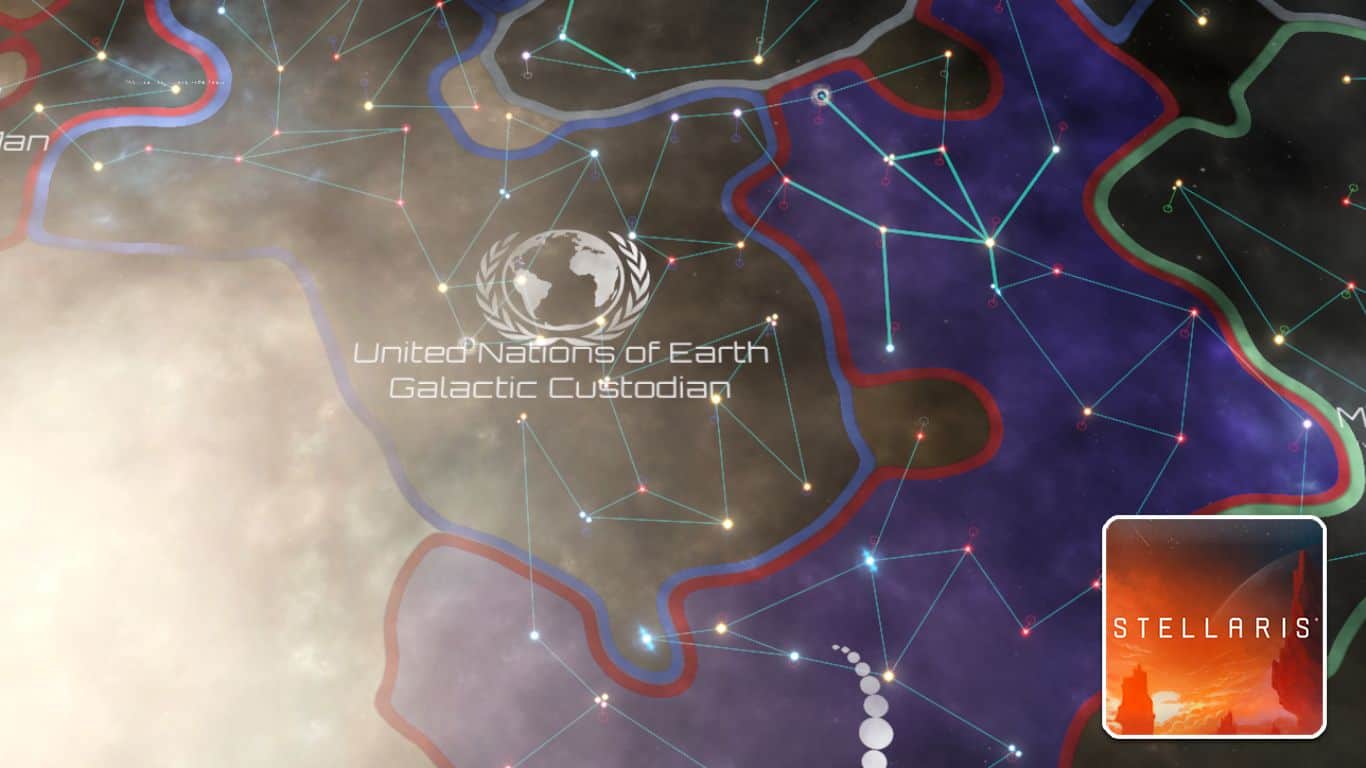If you are new to Stellaris, you might not have ever heard of the Empire Size mechanic. Empire Size is a numerical value assigned to every empire, which represents how difficult it is for the empire to run.
Knowing how to interact with this subtle and nuanced game system; is the first step in becoming a great Stellaris player. If you have reached the end game in the past and found the challenges there beyond your empire. That is a sign that you are not managing your empire size as well as you could be.
Recommended Read: How to Merge Fleets in Stellaris
Going over your empire size score will slow down your empire’s advancement, and if your opponents do not have these debuffs, they will leave you in the dust.
Empire Size increases along with the size of your empire. For every point over 100 Empire Size, the cost of technology, traditions, edicts, and power projection will increase.
Table of Contents
- How to Manage Empire Size in Stellaris
- How Does Empire Size Work
- How to grow your Empire Size
- How to Reduce Empire Size
- What is the Optimal Empire Size
How to Manage Empire Size in Stellaris
Empire size has changed a lot over the years in Stellaris. One of the biggest changes is the name change from Empire Sprawl. Empire sprawl is still used by the community, and the terms are interchangeable.
Two strategies stand out when we talk about empire size. There is the playing tall strategy. This involves min-maxing all of your planets, pops, and systems; to keep empire size as low as possible.
The lower the empire size, the lower the cost for advancement, and this allows your empire to speed ahead of the competition.
The other strategy is playing wide. This involves throwing caution to the wind regarding empire size. You grab as much territory as you can and exploit all of the resources you can get your hands on.
The more resources you have, the easier it is to offset the debuffs for a high empire size.
Both of these strategies are valid, and both come with their strengths and weaknesses. More on that later.
In the past, the end game was near impossible for wide empires to survive, and playing tall was the clear meta. After a lot of patches, both of these playstyles are now viable to win you the game.
How Does Empire Size Work
Even though you don’t see the daily management of your glorious space empire, you can imagine that the larger it is, the more difficult it would be to manage. The more planets, people, and infrastructure you have, the harder it is to run. Empire size is a simplified numerical value of that logistical challenge.
Every time your empire grows larger, you will incur an empire-size cost. A list of everything that will increase empire size is as follows:-
- Colonies- Cost 10 empire size each.
- Pops- Cost 1 empire size each.
- Systems- Cost 1 empire size each.
- Districts- Cost 0.5 empire size each.
- Branch offices- Cost 2 empire size each. Requires the Megacorp DLC.
As you can see, these are all lucrative resources that you usually want as many of as possible. All empires have a soft cap of 100 empire size.
When you go over the cap, your empire will start to incur penalties. These penalties stack for every point you are over 100. The penalties you will incur are as follows:-
- 0.2 percent increase to tradition cost.
- 0.1 percent increase in technology cost.
- 1 percent increase in the cost of edicts.
- Enemy empires gain 0.25 daily infiltration buffs on you.
- An extra 10 unity to pay for government reforms.
- An extra 2 naval capacity to maintain power projection.
- Another 10 unity to pay for planetary ascension tiers.

Being a hive-mind empire reduces these penalties by 25 percent. Being a dictatorial empire reduces it by 10 percent. Finally, being a corporate empire increases these penalties by 25 percent.
Going over the soft cap is not the end of the world and is certain to happen in most playthroughs. Ever since Empire Sprawl was changed to Empire Size, there is no way to increase the base cap of 100.
Before we could increase the cap and make empire sprawl penalties a non-issue. That strategy is no longer available, and you need to use new tactics.
How to grow your Empire Size
I mentioned the two strategies used when it comes to growing your empire size. There is playing tall and playing wide.
Playing Tall
Playing tall is for the slower and more deliberate Stellaris players. This strategy is all about keeping empire size as low as possible by having a small empire with few planets.
Colonies give you the most empire size, so they are the enemy of tall players. Planets increase pop production and contain districts which will further increase empire size.
The longer you can stay under the cap as a tall player, the better. Tall players will create their empires with empire-size modifiers in mind. They tend to favor pacifist tactics and will avoid expansionist wars.
Once a tall player has all the technology and resources they need, empire-size penalties are no longer a problem. This strategy is sometimes called “turtling” and it isn’t for everyone.
One of its greatest strengths is that it makes managing your empire much easier and is a great tactic for new players. Some advanced players find this method boring and instead opt for the playing wide approach.
Playing Wide
Playing wide is for the faster and more spontaneous Stellaris players. This strategy is all about maximizing your resource production to offset any penalties you from having a large empire size. If you can see it, you take it. The more systems and planets you have, the more you can produce.
Making use of empire-size modifiers is still valid for tall players but is secondary to resource production.
When using this strategy, you will want to construct as many research and unity buildings as you can. This is especially important in the early game when your empire-size penalty is small.
Genocidal or expansionist style empires tend to flourish in a wide game style. When creating your empire, you will want to focus on buffs to research and unity production.
This tactic is more suited to the player who prefers a faster gameplay experience. Border wars will be common, as will managing loads of planets and pops.
This style of play is a trap a lot of new players will fall into. They will expand randomly and soon find themselves overwhelmed with the micromanaging that is now expected of them.
How to Reduce Empire Size
Like war, generating empire size is certain when playing Stellaris. You can’t avoid it, so choosing how to interact with it on your terms is the best strategy. One way we can do this is by making use of empire-size modifiers. Depending on the empire you create, you will only have access to so many of these modifiers.
At empire creation, you can stack modifiers on the empire you are making to give yourself an early advantage over opponents. We have a wide range to select from at empire creation, and this topic could be a guide all on its own. In brief, we can make use of the following:-
- Traits- Docile and Streamlined Protocols
- Civics- Subsumed Will, OTA Updates, Beacon of Liberty, Divided attention, Private Prospectors, and Franchising Civics.
- Ethics- Being any form of Pacifist empire reduces empire size.
- Authority- Machine empires enjoy great reductions in empire size costs.

During gameplay, we have multiple ways to reduce empire size. In the traditions tab, the Courier Network tradition and Imperial Prerogative ascension perk are two of the most powerful ways to reduce empire size.
There is the Modular Despots tradition for machine empire; also finishing the Domination, Harmony, and Synchronicity tradition trees reduces empire size.
A lot of the galactic community resolutions can affect your empire’s size. Most of these will make your empire produce more empire size.
Which you do not want in most cases. Be sure to keep an eye on what the galactic community is voting on and call in favors to block laws that may hinder your progress.
There are only two technologies that help reduce empire size. These are Construction Templates and Psionic Theory. Both of these techs are rare, and it will be late into a playthrough that you get them.
Finally, we can pay unity to assign planetary ascension tiers to our colonies. These tiers will reduce the cost of everything that produces empire size on the planet by 5 percent. This bonus also applies to the planet itself too. This bonus can be stacked by assigning more tiers to the planet.
Outside of empire size modifiers, there are a couple of things you can do to reduce your empire size. Abandoning systems or planets is one way to reduce size, but this is a lot of work for very little reward.
The superior way is to create a vassal in one of the outlier systems. This is easy to do and also provides you with an ally to help prop up your empire.
What is the Optimal Empire Size
The optimal empire size is as small as possible, but as previously discussed, this isn’t always viable. Staying under the cap will result in you needing to handicap your empire.
The optimal empire size now is to find the style of game that you enjoy and optimize your empire around that. Being mindful of the empire-size mechanic and ensuring it doesn’t get away from you is the best tactic to employ.
This is everything you need to know about empire size in its current state in Stellaris.
It can seem like a large, punishing, and even complicated mechanic, but it isn’t. If you are taking the time to monitor your empire size, you have already taken the next steps toward becoming an advanced Stellaris player.
If you have any suggestions or comments for this guide, please let us know in the comment section below. Thank you for reading this guide, have a great day.




